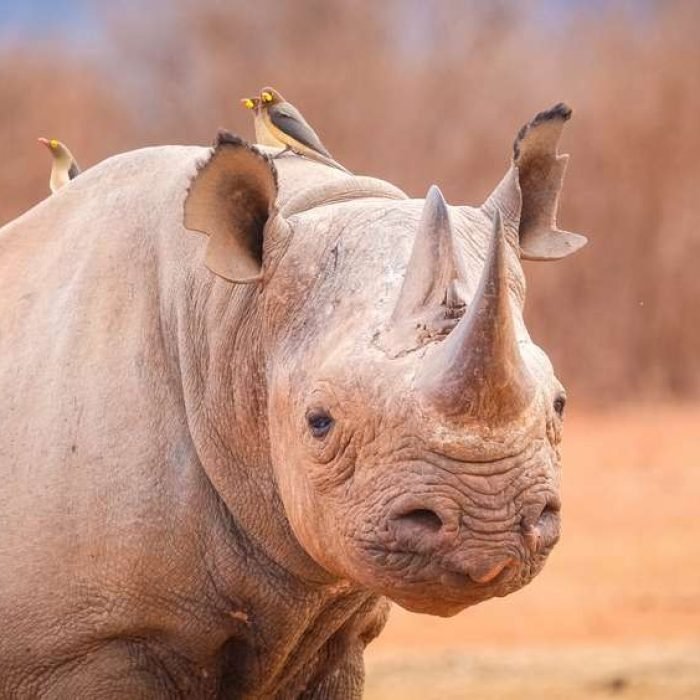Grant’s Zebra
( Upper zambezi zebra or small zebra )
- Equus quagga boehmi or Equus quagga zambeziensis
- IUCN Status: Near Threatened
- Trend: decreasing

General Information
The Grant’s zebra is the smallest of the seven subspecies of the plains zebra. Zebras have shiny coats that dissipate over 70% of incoming heat. The black and white stripes are a form of camouflage called disruptive coloration that breaks up the outline of the body. Although the pattern is visible during daytime, at dawn or in the evening when their predators are most active, zebras look indistinct and may confuse predators by distorting true distance. Zebra are known to have the most deadliest kick in the animal kingdom. When threatened, an adult zebra can kill a fully grown male African lion with a single blow to the body. Though it is difficult to get a precise measurement, it is thought that a zebra can kick with nearly 136 kg of force.
Description
The smallest zebra. Females and males are about the same size. The stripes of a zebra are unique on each animal, like fingerprints.
Fun Facts
Grant’s zebra are the smallest of the seven subspecies of the plains zebra.
Ecology & Behaviour
Zebra are related to the Horse family and are gregerious in nature. Family groups are stable members maintaining strong bonds over many years. Mutual grooming, where zebras stand together and nibble the hair on each other’s neck and back, helps develop and preserve these bonds. Family members look out for one another, if one becomes separated from the rest, the others search for it. The group adjusts its traveling pace to accommodate the old and the weak. Zebras are important prey for lions and hyenas, and to a lesser extent for hunting dogs, leopards and cheetahs. When a family group is attacked, the members form a semicircle, face the predator and watch it, ready to bite or strike should the attack continue. If one of the family is injured the rest will often encircle it to protect it from further attack. They usually move in groups and usually with wildebeest, hartebeest or roan.
Distribution & Habitat
Zebras are found in most of the Parks but more abundantly in the South Luangwa National Park.
This subspecies is distributed in Zambia west of the Luangwa river west to Kariba, Katanga Province of the Democratic Republic of the Congo, north to the Kibanzao Plateau, and in Tanzania north from Nyangaui and Kibwezi into southwestern Kenya as far as Sotik. It can also be found in eastern Kenya and east of the Great Rift Valley into southernmost Ethiopia. It occurs as far as the Juba River in Somalia.
Diet
Zebra are related to the Horse family and are gregerious in nature. Family groups are stable members maintaining strong bonds over many years. Mutual grooming, where zebras stand together and nibble the hair on each other’s neck and back, helps develop and preserve these bonds. Family members look out for one another, if one becomes separated from the rest, the others search for it. The group adjusts its traveling pace to accommodate the old and the weak. Zebras are important prey for lions and hyenas, and to a lesser extent for hunting dogs, leopards and cheetahs. When a family group is attacked, the members form a semicircle, face the predator and watch it, ready to bite or strike should the attack continue. If one of the family is injured the rest will often encircle it to protect it from further attack. They usually move in groups and usually with wildebeest, hartebeest or roan.
Reproduction
Zebra are related to the Horse family and are gregerious in nature. Family groups are stable members maintaining strong bonds over many years. Mutual grooming, where zebras stand together and nibble the hair on each other’s neck and back, helps develop and preserve these bonds. Family members look out for one another, if one becomes separated from the rest, the others search for it. The group adjusts its traveling pace to accommodate the old and the weak. Zebras are important prey for lions and hyenas, and to a lesser extent for hunting dogs, leopards and cheetahs. When a family group is attacked, the members form a semicircle, face the predator and watch it, ready to bite or strike should the attack continue. If one of the family is injured the rest will often encircle it to protect it from further attack. They usually move in groups and usually with wildebeest, hartebeest or roan.
Conservation
They are listed as a “Near Threatened” species on the IUCN Red List and are decreasing in number.
Share:
- Kingdom: Animalia
- Phylum: Chordata
- Class: Mammalia
- Order: Perissodactyla
- Family: Equidae
- Genus: Equus
- Shoulder height: 120 to 140 cm
- Length: 182 to 243 cm
- Weight: avg 300 kg
- Lifespan: 20 yrs













